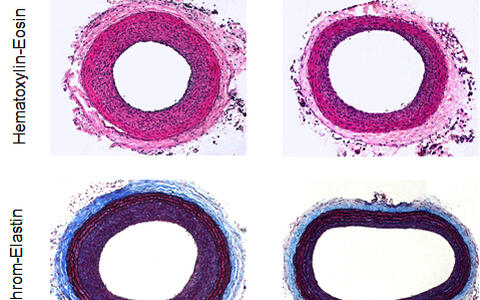
Nuclear Receptors as Potential Target for the Treatment and Prevention of Cardiovascular Disease
Nuclear Receptors as Potential Target for the Treatment and Prevention of Cardiovascular Disease
Figure: The LXR ligand T1317 inhibits neointimal hyperplasia at 2 weeks after injury. Representative photomicrographs of histological cross-sections of balloon-injured rat carotid arteries. Sections were stained with hematoxylin-eosin or trichrom-elastin.
We focus on exploring the role of nuclear receptors, such as PPARs (peroxisome proliferator-activated receptors) and LXR (liver X receptor) as potential target for the prevention and treatment of cardiovascular disease. Despite improved treatment options, cardiovascular disease is the leading cause of mortality in industrialized nations, accounting for nearly 50% of all death.
Antiinflammatory and Antiproliferative Nuclear Receptor Signaling Pathways in Vascular Smooth Muscle Cells
Activation and proliferation of vascular smooth muscle cells (VSMCs) are recognized to play a decisive role in vascular proliferative diseases such as primary atherosclerosis, postangioplasty restenosis, vein graft graft disease, and transplant vasculopathy. Due to the crucial role of VSMCs in the pathobiology of vascular occlusive disease, a pharmacologic blockade of VSMC activation and the cell cycle machinery is a promising therapeutic approach to prevent and treat vascular proliferative disease. Using both in vitro and in vivo approaches, we are currently investigating the role of various nuclear receptors and their activation by synthetic ligands in VSMC activation and cell cycle progression and are characterizing the molecular pathways utilized to regulate gene expression.
Role of Nuclear Receptors in Cardiac Metabolism and Hypertrophy
Cardiac hypertrophy leading to heart failure is a major cause of morbidity and mortality worldwide. The reason why cardiac dilatation and failure eventually occur are unknown although alterations in energy status and metabolism are proposed to play an important role. An understanding of the role of cardiac energy metabolism and hypertrophic gene expression in the pathology of cardiomyopathy may consequently lead to more effective novel therapeutic strategies for the prevention and treatment of heart failure. We are currently elucidating the role of nuclear receptors in cardiac metabolism and hypertrophy and characterize the molecular mechanism(s) utilized to regulate gene expression involved in cardiomyocyte growth and energy metabolism.
Given their pleiotropic effects of nuclear receptors and their activation by specific ligands in lipid and glucose homeostasis, cardiac energy balance and regulation of inflammatory gene expression, new drugs targeting nuclear receptor are emerging as promising therapeutics for the treatment of diabetes, obesity, atherosclerosis, restenosis and heart failure.
Relevant Publications:
Blaschke F, Takata Y, Caglayan E, Collins A, Tontonoz P, Hsueh WA, Tangirala RK.
A nuclear receptor corepressor-dependent pathway mediates suppression of cytokine-induced C-reactive protein gene expression by liver X receptor. Circ Res. 2006 Dec 8;99(12):e88-99. Epub 2006 Nov 16.
Blaschke F, Caglayan E, Hsueh WA.
Peroxisome proliferator-activated receptor gamma agonists: their role as vasoprotective agents in diabetes. Endocrinol Metab Clin North Am. 2006 Sep;35(3):561-74.
Blaschke F, Takata Y, Caglayan E, Law RE, Hsueh WA.
Obesity, peroxisome proliferator-activated receptor, and atherosclerosis in type 2 diabetes. Arterioscler Thromb Vasc Biol. 2006 Jan;26(1):28-40. Epub 2005 Oct 20.
Ogawa D, Stone JF, Takata Y, Blaschke F, Chu VH, Towler DA, Law RE, Hsueh WA, Bruemmer D.
Liver x receptor agonists inhibit cytokine-induced osteopontin expression in macrophages through interference with activator protein-1 signaling pathways. Circ Res. 2005 Apr 15;96(7):e59-67. Epub 2005 Mar 24.
Blaschke F, Leppanen O, Takata Y, Caglayan E, Liu J, Fishbein MC, Kappert K, Nakayama KI, Collins AR, Fleck E, Hsueh WA, Law RE, Bruemmer D.
Liver X receptor agonists suppress vascular smooth muscle cell proliferation and inhibit neointima formation in balloon-injured rat carotid arteries. Circ Res. 2004 Dec 10;95(12):e110-23. Epub 2004 Nov 11.
Blaschke F, Bruemmer D, Yin F, Takata Y, Wang W, Fishbein MC, Okura T, Higaki J, Graf K, Fleck E, Hsueh WA, Law RE.
C-reactive protein induces apoptosis in human coronary vascular smooth muscle cells. Circulation. 2004 Aug 3;110(5):579-87. Epub 2004 Jul 26.
Involved Scientists
Florian Blaschke (Postdoc)
Arnd Heuser (Postdoc)
Timm Zörgiebel (PhD student)

